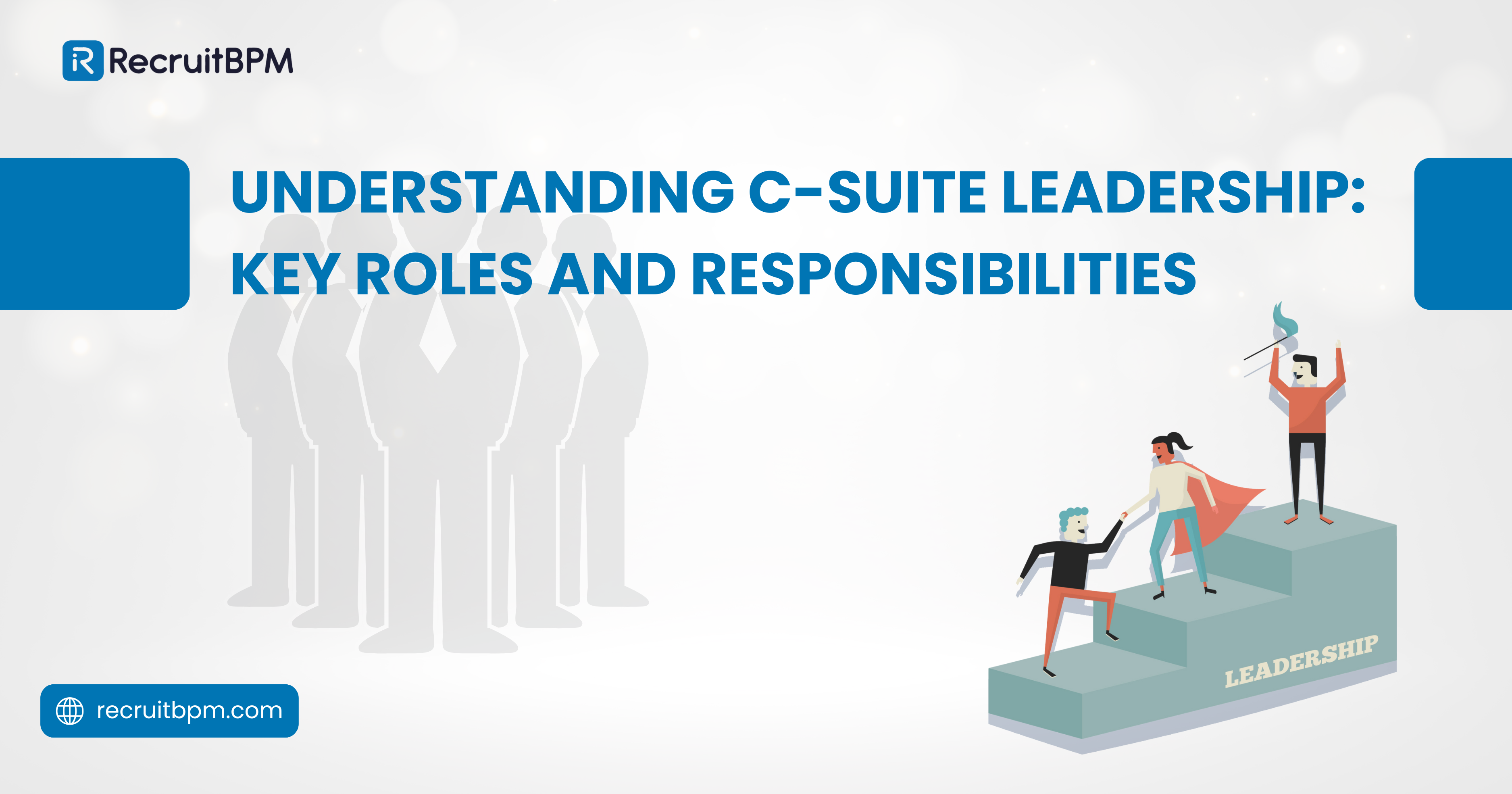Organizations succeed or fail based on leadership quality at the highest levels. The strategic decisions, cultural tone, and operational direction established by top executives ripple throughout entire companies, determining competitive positioning and long-term viability.
The C-suite represents this critical leadership layer where vision transforms into reality and accountability concentrates at its highest intensity. For recruitment agencies, understanding C-suite dynamics, composition, and recruitment nuances unlocks the most lucrative and impactful segment of talent acquisition. Mastering C-suite recruitment separates agencies commanding premium market positioning from those operating in commoditized hiring segments.
What is C-Suite?
The C-suite is the group of executives responsible for running an organization, comprising the highest-ranking executive positions whose titles typically begin with “Chief.” The C-suite refers to several corporate executive positions in a company with the word “chief” in the job title, including chief executive officer (CEO), chief financial officer (CFO), and chief technology officer (CTO).
Role and Importance of C-Suite Executives
C-suite executives, also called C-level executives, are the top tier of executives at any company who hold the most decision-making power within organizations. C-level executives work together to ensure that companies stay true to established plans and policies while making high-stakes decisions that affect entire organizations.
Composition of the C-Suite
The makeup of each C-suite is unique: while most organizations have a CEO and a CFO, the specific composition varies based on company size, industry, strategic priorities, and organizational complexity. Common C-suite positions include:
Chief Executive Officer (CEO) – The highest-ranking executive responsible for overall company direction, major corporate decisions, and serving as primary liaison between board of directors and operations.
Chief Financial Officer (CFO) – Senior executive managing financial planning, risk management, financial reporting, and strategic financial direction ensuring fiscal health and compliance.
Chief Operating Officer (COO) – Executive overseeing daily business operations, implementing CEO strategies, and optimizing operational efficiency across departments.
Chief Technology Officer (CTO) – Leader directing technology strategy, innovation initiatives, and technical capabilities that drive competitive advantage.
Chief Information Officer (CIO) – Executive managing information systems, data infrastructure, cybersecurity, and technology operations supporting business functions.
Chief Marketing Officer (CMO) – Senior leader developing brand strategy, customer acquisition programs, market positioning, and revenue growth initiatives.
Chief Human Resources Officer (CHRO) – Executive overseeing talent strategy, organizational culture, employee engagement, and human capital development.
For decades, the C-suite was a small group with fairly predictable roles from organization to organization, typically limited to CEO, CFO, and COO. Modern C-suites have expanded dramatically, reflecting specialized business needs and emerging priorities. Organizations now commonly include Chief Data Officers, Chief Sustainability Officers, Chief Diversity Officers, Chief Experience Officers, Chief Risk Officers, and numerous other specialized roles addressing contemporary business challenges.
Why C-Suite Matters for Recruitment Agencies?
The C-suite recruitment market represents the pinnacle of talent acquisition services, offering strategic and financial advantages that justify specialized investment in executive search capabilities.
Premium economics justify specialization
C-suite placements generate fees ranging from 25-35% of first-year total compensation, significantly exceeding standard recruitment rates. When C-suite salaries span $300,000-$1,000,000+ annually, individual placements produce $75,000-$350,000+ in revenue. These economics support extended search timelines, comprehensive assessment processes, and sophisticated candidate engagement that lower-level placements cannot justify.
Strategic client relationships emerge naturally
Organizations entrusting recruitment agencies with C-suite searches demonstrate profound confidence in agency capabilities and judgment. Successfully placing executives who drive organizational success creates enduring partnerships extending far beyond transactional relationships. C-suite search clients become sources of ongoing recruitment needs across all organizational levels, referrals to peer companies, and potential retainer agreements for continuous executive advisory services.
Market dynamics create sustained demand
Executive turnover, organizational growth, digital transformation initiatives, succession planning challenges, and competitive talent wars generate continuous C-suite recruitment needs. Unlike cyclical mid-level hiring that fluctuates with economic conditions, C-suite recruitment maintains steadier demand reflecting strategic imperatives that transcend short-term market fluctuations.
Competitive barriers protect positioning
C-suite recruitment requires capabilities most agencies lack—board-level relationships, sophisticated assessment methodologies, executive compensation expertise, confidential search management, and proven track records placing senior leaders successfully. These barriers to entry limit competition, enabling agencies mastering C-suite recruitment to command premium pricing without commoditized competition.
Industry influence amplifies reputation
Successful C-suite placements generate visibility within industries as new executives assume prominent roles. Recruitment agencies behind these placements gain a reputation as kingmakers capable of identifying and placing transformational leaders. This reputation becomes self-reinforcing as success attracts more prestigious search opportunities.
Advisory opportunities extend beyond placement
C-suite recruitment naturally evolves into strategic consulting around organizational design, leadership team composition, succession planning, and talent strategy. These advisory relationships generate consulting revenue, supplementing placement fees while deepening client partnerships through ongoing engagement rather than episodic transactions.
Long-term placement stability enhances track record
C-suite executives carefully evaluate opportunities before accepting, researching organizations thoroughly and negotiating comprehensive terms. This deliberation reduces premature departure risks compared to mid-level hires who may exit within months. Successful C-suite placements enduring years become powerful case studies demonstrating recruitment agency capability.
Global reach expands addressable markets
C-suite searches increasingly cross geographic boundaries as organizations seek best available talent regardless of location. Remote and hybrid work arrangements, particularly prevalent at executive levels, further expand candidate pools. Recruitment agencies developing C-suite expertise can access global markets rather than being constrained by local candidate availability.
How to Use C-Suite Effectively?
Successfully recruiting C-suite executives demands fundamentally different approaches than standard hiring, requiring specialized methodologies, extensive networks, and sophisticated stakeholder management capabilities.
Cultivate board-level access systematically
C-suite hiring decisions involve boards of directors who ultimately approve senior appointments. Recruitment agencies lacking board relationships struggle to influence or sometimes even access C-suite search opportunities. Develop board networks through professional associations, thought leadership, conference participation, and strategic relationship cultivation with board members, investors, and ownership groups.
Develop deep industry vertical expertise
Generalist approaches fail in C-suite recruitment where nuanced industry knowledge proves essential for credible stakeholder engagement and accurate candidate assessment. Specialize in specific sectors—technology, healthcare, financial services, manufacturing, retail—building expertise enabling sophisticated conversations with boards and executives while accurately evaluating candidate capabilities within industry contexts.
Master confidential search orchestration
Most qualified C-suite candidates are successfully employed and value discretion absolutely. Executive searches demand confidential outreach, discrete discussions, and relationship building over extended periods without jeopardizing current positions. Develop communication protocols, confidentiality agreements, and discrete engagement methodologies protecting all parties throughout multi-month processes.
Implement multi-dimensional assessment frameworks
C-suite evaluation extends far beyond resume credentials and interviews. Comprehensive assessment includes leadership competency evaluation, strategic thinking assessment, cultural alignment analysis, extensive reference checking with board members and investors, thorough background verification, and sometimes psychological or behavioral assessments. Multi-faceted evaluation reduces costly executive hiring mistakes that damage organizations and agency reputations.
C-suite compensation packages include base salary, annual incentives, long-term incentive plans, equity grants (stock options, restricted stock, performance shares), retirement contributions, supplemental benefits, perquisites, severance agreements, and change-in-control provisions. Navigate these complex structures competently, advising both clients and candidates on market-competitive packages that close placements successfully without leaving value gaps that cause deal failures.
Conduct comprehensive due diligence on all parties
Investigate client organizations thoroughly before accepting C-suite search engagements. Financial stability, board dynamics, strategic direction clarity, competitive positioning, and organizational culture significantly impact executive success likelihood. Similarly, verify candidate backgrounds meticulously—previous company performance, leadership team feedback, professional reputation, and cultural fit indicators—since C-suite failures create severe organizational consequences.
Build executive talent pipelines proactively
Maintain ongoing relationships with high-potential executives years before specific search needs arise. Attend industry conferences, host executive roundtables, publish research, and cultivate networks systematically. When search opportunities emerge, established relationships dramatically accelerate candidate engagement compared to cold outreach competing with multiple other executive recruiters.
Develop compelling organizational narratives
Successfully employed C-suite candidates need compelling reasons to explore new opportunities beyond compensation increases. Craft narratives around transformation challenges, industry leadership opportunities, strategic imperatives, legacy-building possibilities, and cultural alignment that resonate with executive motivations. Generic job descriptions fail; compelling stories attract attention.
Manage complex stakeholder dynamics skillfully
C-suite searches involve boards, investors, ownership groups, existing executive teams, and sometimes key customers or partners. These stakeholders often have competing priorities and different candidate preferences. Navigate these dynamics through systematic stakeholder alignment, transparent communication, and political acumen that builds consensus around optimal candidates.
Position the agency as a strategic advisor, not a vendor
Transcend transactional placement provider positioning by offering strategic counsel on organizational design, leadership team composition, succession planning strategies, and talent development initiatives. This consultative approach generates additional revenue while strengthening client relationships through ongoing value delivery beyond individual placements.
Leverage market intelligence and competitive analysis
C-suite recruitment requires a sophisticated understanding of competitive executive movements, emerging industry leaders, organizational performance patterns, and compensation trends. Invest in research capabilities, data analytics, and market monitoring informing strategic recommendations to clients and candidates. Intelligence-driven insights differentiate professional executive search from amateur recruiting.
Establish rigorous process discipline and project management
C-suite searches spanning months require systematic orchestration—search strategy documentation, stakeholder alignment cadences, candidate pipeline management, assessment coordination, communication protocols, and timeline tracking. Process discipline prevents searches from stalling or losing momentum while ensuring nothing falls through cracks during complex, extended engagements.
Common Challenges with C-Suite
Despite substantial rewards, C-suite recruitment presents distinct challenges that agencies must navigate successfully to build sustainable executive search practices generating consistent revenue and reputation.
Extended search timelines strain resources and cash flow
C-suite searches commonly span 4-9 months from engagement to placement, with complex situations extending beyond a year. These prolonged timelines delay revenue recognition while consuming substantial resources, including senior recruiter time, research efforts, and administrative support. Agencies accustomed to 45-60 day placement cycles struggle with C-suite economics requiring different financial planning and resource allocation models.
Cultural alignment assessment remains a subjective challenge
While technical qualifications and experience can be evaluated objectively, cultural fit assessment involves subjective judgment that even experienced executive recruiters find difficult. C-suite failures often trace to cultural misalignment rather than capability gaps—executives with impressive credentials struggling in organizational cultures incompatible with their leadership styles. Developing reliable cultural assessment frameworks beyond gut instinct requires sophisticated methodologies.
Confidentiality requirements create operational complexity
C-suite searches demand extraordinary discretion, protecting candidates current positions and avoiding market speculation about client leadership changes. Managing confidential processes while coordinating multiple stakeholders, conducting reference checks, and negotiating offers creates logistical challenges that standard recruitment processes don’t encounter. Confidentiality breaches damage all parties and destroy agency credibility.
Compensation negotiations involve protracted multi-party discussions
C-suite offers include numerous components requiring board approval, compensation committee review, investor input, and extensive legal documentation. Negotiations extend over weeks or months, involving multiple term adjustments, changing economic conditions, and stakeholder alignment challenges. Failed negotiations after months of work create devastating outcomes for recruitment agencies that invested substantial non-recoverable resources.
Candidate pools remain limited, intensifying competition
Truly qualified C-suite candidates for specific industries, company situations, and strategic challenges number in dozens rather than hundreds. Multiple executive search firms often pursue the same small candidate pool simultaneously, with retained and contingent recruiters competing for relationships. Differentiation requires superior client opportunities, stronger candidate relationships, a demonstrated track records that take years to build.
Board and investor dynamics introduce decision complexity
C-suite hiring decisions involve numerous stakeholders with potentially conflicting priorities. Board members may disagree about ideal candidate profiles; investors might prioritize different capabilities than existing management teams; founders may resist external executives threatening their influence. Navigating these dynamics requires political acumen, stakeholder management skills, and negotiation capabilities beyond typical recruitment expertise.
Failure consequences amplify pressure and risk aversion
Poor C-suite hires create severe organizational damage—strategic missteps, cultural disruption, talent exodus, competitive setbacks, and substantial financial losses. These high stakes make clients extremely risk-averse, demanding extensive validation through reference checks, assessment processes, and sometimes probationary arrangements that lengthen timelines. Risk aversion sometimes prevents decisions despite strong candidates, causing searches to stall indefinitely.
Market intelligence development demands continuous investment
C-suite recruitment requires a sophisticated understanding of competitive dynamics, organizational performance, emerging leaders, succession patterns, and industry trends. Developing and maintaining this intelligence demands ongoing research investment, including subscriptions, analyst relationships, and dedicated research personnel, which smaller agencies struggle justifying when C-suite placements represent small percentages of total business.
Geographic constraints persist despite remote flexibility
While remote work has expanded geographic flexibility for some C-suite roles, many organizations and candidates prefer headquarters proximity for senior leadership, ensuring cultural integration and stakeholder access. These location preferences constrain candidate pools and force difficult trade-offs between ideal candidates in the wrong locations versus acceptable candidates in the right locations.
Reference checking presents unique sensitivity challenges
Verifying C-suite executive performance through references requires extraordinary discretion since appropriate references include board members, investors, and C-suite peers. Accessing these references without alerting markets to leadership searches or damaging candidate current positions challenges even for experienced recruiters. Superficial reference checking risks missing critical performance concerns; thorough checking risks confidentiality breaches.
Diverse C-suite pipeline development requires sustained effort
Building diverse C-suite candidate networks demands years of relationship cultivation rather than short-term recruiting tactics. Systemic pipeline gaps at senior leadership levels mean diverse C-suite candidates remain scarce, making agencies dependent on limited networks and unable to quickly respond to diversity mandates from boards and investors.
Succession planning complexity creates ambiguous search parameters
Some C-suite searches serve dual purposes—finding external candidates while evaluating internal successors as backup options or competitive benchmarks. These ambiguous situations complicate candidate engagement since external candidates perceive themselves competing against insiders with informational and political advantages. Managing these dynamics requires transparency about internal candidate status without discouraging external candidate interest.

















